Dimensional Stability of Mirror Substrates Made of Silicon Particle Reinforced Aluminum
Abstract
:1. Introduction
2. Materials and Methods
2.1. Materials
2.2. Methods
3. Results
3.1. Microstructure of Al-42Si
3.2. Dimensional Stability upon Thermal Cycling
3.3. TEM Analysis
4. Discussion
5. Conclusions
- For ultra-precise mirrors, a material analysis of residual changes of shape deviation in the addressed temperature range is necessary.
- Thermal treatments at 360 °C and thermal cycling (−40 °C to 60 °C and −196 °C to 20 °C, respectively) of silicon particle reinforced aluminum materials lead to an increasing number of dislocations in the aluminum phase and to an increasing number of stacking faults in the silicon phase.
- Thermal cycling between −40 °C and 60 °C and −196 °C and 20 °C, respectively, lead to higher dimensional stability of silicon particle reinforced aluminum materials due to cold working of the ductile aluminum matrix caused by different coefficients of the thermal expansion of the two phases, aluminum and silicon.
Author Contributions
Funding
Institutional Review Board Statement
Informed Consent Statement
Data Availability Statement
Acknowledgments
Conflicts of Interest
References
- Steinkopf, R.; Gebhardt, A.; Scheiding, S.; Rohde, M.; Stenzel, O.; Gliech, S.; Giggel, V.; Löscher, H.; Ullrich, G.; Rucks, P.; et al. Metal Mirrors with Excellent Figure and Roughness. Proc. SPIE 2008, 7102, 71020C-1–71020C-12. [Google Scholar]
- Risse, S.; Gebhardt, A.; Damm, C.; Peschel, T.; Stöckl, W.; Feigl, T.; Kirschstein, S.; Eberhardt, R.; Kaiser, N.; Tünnermann, A. Novel TMA telescope based on ultra precise metal mirrors. Proc. SPIE 2008, 7010, 701016-1–701016-8. [Google Scholar]
- Vukobratovich, D.; Schaefer, J.P. Large stable aluminum optics for aerospace applications. Proc. SPIE 2011, 8125, 81250T-1–81250T-13. [Google Scholar]
- Brandl, B.R.; Lenzen, R.; Pantin, E.; Glasse, A.; Blommaert, J.; Venema, L.; Molster, F.; Siebenmorgen, R.; Boehnhardt, H.; van Dishoeck, E.; et al. METIS: The Mid-infrared E-ELT Imager and Spectrograph. Proc. SPIE 2008, 7014, 70141N-1–70141N-15. [Google Scholar]
- Kinast, J.; Hilpert, E.; Lange, N.; Gebhardt, A.; Rohloff, R.-R.; Risse, S.; Eberhardt, R.; Tünnermann, A. Minimizing the bimetallic bending for cryogenic metal optics based on electroless nickel. Proc. SPIE 2014, 9151, 915136-1–915136-9. [Google Scholar]
- Rohloff, R.-R.; Gebhardt, A.; Schönherr, V.; Risse, S.; Kinast, J.; Scheiding, S.; Peschel, T. A novel athermal approach for high performance cryogenic metal optics. Proc. SPIE 2010, 7739, 77394E-1–77394E-14. [Google Scholar]
- Schubert, J.; Davis, R.; Hartl, M.; Hörmann, V.; Garrel, V.; Manhart, M.; Kampf, D.; Barl, L.; Mandla, C.; Sturm, E.; et al. The MICADO first light imager for ELT: Cold optics instrument. Proc. SPIE 2018, 10702, 107028W-1–107028W-12. [Google Scholar]
- Fei, W.D.; Wang, L.D. Thermal expansion behavior and thermal mismatch stress of aluminum matrix composite reinforced by β-eucryptite particle and aluminum borate whisker. Mater. Chem. Phys. 2003, 85, 450–457. [Google Scholar] [CrossRef]
- Fei, W.D.; Hu, M.; Yao, C.K. Effects of thermal residual stress creeping on microstructure and tensile properties of SiC whisker reinforced aluminum matrix composite. Mater. Sci. Eng. A 2003, 356, 17–22. [Google Scholar] [CrossRef]
- Fei, W.D.; Hu, M.; Yao, C.K. Thermal expansion and thermal mismatch stress relaxation behaviors of SiC whisker reinforced aluminum composite. Mater. Chem. Phys. 2002, 77, 882–888. [Google Scholar] [CrossRef]
- Huang, Y.D.; Hort, N.; Kainer, K.U. Thermal behavior of short fiber reinforced AlSi12CuMgNi piston alloys. Compos. Part A Appl. Sci. Manuf. 2004, 35, 249–263. [Google Scholar] [CrossRef]
- Requena, G.; Yubero, D.C.; Corrochano, J.; Repper, J.; Garcés, G. Stress relaxation during thermal cycling of particle reinforced aluminium matrix composites. Compos. Part A Appl. Sci. Manuf. 2012, 43, 1981–1988. [Google Scholar] [CrossRef]
- Goswami, R.K.; Dhar, A.; Srivastava, A.K.; Gupta, A.K.; Grover, O.P.; Jindal, U.C. Effect of Deformation and Ceramic Reinforcement on Work Hardening Behaviour of Hot Extruded 2124 Al-SiCp Metal Matrix Composite. J. Compos. Mater. 1998, 33, 1160–1172. [Google Scholar] [CrossRef]
- Zong, B.Y.; Zhang, F.; Wang, G.; Zuo, L. Strengthening mechanism of load sharing of particulate reinforcements in a metal matrix composite. J. Mater. Sci. 2007, 42, 4215–4226. [Google Scholar] [CrossRef]
- Zhang, J.; Perez, R.J.; Lavernia, E.J. Dislocation-induced damping in metal matrix composites. J. Mater. Sci. 1993, 28, 835–846. [Google Scholar] [CrossRef]
- Zhang, H.; Gu, M. Study on the damping behavior of Al/SiCp composite in thermal cycling. J. Mater. Sci. 2007, 42, 6260–6266. [Google Scholar] [CrossRef]
- Pang, X.; Xian, Y.; Wang, W.; Zhang, P. Tensile properties and strengthening effects of 6061Al/12 wt%B4C composites reinforced with nano-Al2O3 particles. J. Alloy. Compd. 2018, 768, 476–484. [Google Scholar] [CrossRef]
- Fernández, R.; Cabeza, S.; Mishurova, T.; Fernández-Castrillo, P.; González-Doncel, G.; Bruno, G. Residual stress and yield strength evolution with annealing treatments in an age-hardenable aluminum alloy matrix composite. Mater. Sci. Eng. A 2018, 731, 344–350. [Google Scholar] [CrossRef]
- Kroeger, F.R.; Swenson, C.A. Absolute linear thermal-expansion measurements on copper and aluminum from 5 to 320 K. J. Appl. Phys. 1977, 48, 853–864. [Google Scholar] [CrossRef]
- Watanabe, H.; Yamada, N.; Okaji, M. Linear Thermal Expansion Coefficient of Silicon from 293 to 1000 K. Int. J. Thermophys. 2003, 25, 221–236. [Google Scholar] [CrossRef]
- Zhang, Q.; Wu, G.; Jiang, L.; Chen, G. Thermal expansion and dimensional stability of Al-Si matrix composite reinforced with high content SiC. Mater. Chem. Phys. 2003, 82, 780–785. [Google Scholar] [CrossRef]
- Paquin, R.A.; Howells, M.R. Mirror materials for synchrotron radiation optics. Proc. SPIE 1997, 3152, 2–16. [Google Scholar]
- Magner, T.J.; Barney, R.D. Interferometric phase measurement of zerodur, aluminum and SXA mirrors at cryogenic temperatures. Proc. SPIE 1998, 929, 29–38. [Google Scholar]
- Hou, Y.N.; Yang, K.M.; Song, J.; Wang, H.; Liu, Y.; Fan, T.X. A crystal plasticity model for metal matrix composites considering thermal mismatch stress induced dislocations and twins. Sci. Rep. 2021, 11, 16053. [Google Scholar] [CrossRef] [PubMed]
- Marschall, C.W.; Maringer, R.E. Dimensional Instability: An Introduction, 1st ed.; Pergamon Press Ltd.: Oxford, UK, 1977. [Google Scholar]
- Nassini, H.E.; Moreno, M.; Oliver, C.G. Thermal expansion behavior of aluminum alloys reinforced with alumina planar random short fibers. J. Mater. Sci. 2001, 36, 2759–2772. [Google Scholar] [CrossRef]
- Kinast, J.; Grabowski, K.; Rohloff, R.-R.; Risse, S.; Tünnermann, A.; Cugny, B.; Sodnik, Z.; Karafolas, N. Dimensional stability of metal optics on nickel plated AlSi40. Proc. SPIE 2017, 10563, 105635W-1–105635W-9. [Google Scholar]
- Thomas, J.; Gemming, T. Analytical Transmission Electron Microscopy: An Introduction for Operators, 1st ed.; Springer Science+Business Media: Dordrecht, The Netherlands, 2014. [Google Scholar]
- Del Castillo, L.; Hoffman, J.P.; Birur, G. Advanced housing materials for extreme space applications. In Proceedings Aerospace Conference; IEEE: Washington, DC, USA, 2011; pp. 1–6. [Google Scholar]
- Unocic, K.A.; Mills, M.J.; Daehn, G.S. Effect of gallium focused ion beam milling on preparation of aluminium thin foils. J. Microsc. 2010, 240, 227–238. [Google Scholar] [CrossRef]
- Murray, J.; McAllister, A. The Al-Si (Aluminum-Silicon) System. Bull. Alloy. Phase Diagr. 1984, 5, 74–84. [Google Scholar] [CrossRef]
- Goudar, D.M.; Rudrakshi, G.B.; Srivastava, V.C.; Reddy, J.; Joshi, A.G. Spray Deposition Process of Hypereutectic Al-Si alloys: An overview. Int. J. Sci. Eng. Res. 2011, 2, 1–10. [Google Scholar]
- Fujikawa, S.I.; Hirano, K.I.; Fukushima, Y. Diffusion of Silicon in Aluminum. Met. Mater. Trans. A 1978, 9, 1811–1815. [Google Scholar] [CrossRef]
- Matvienko, O.; Daneyko, O.; Kovalevskaya, T.; Khrustalyov, A.; Zhukov, I.; Vorozhtsov, A. Investigation of Stress Induced Due to the Mismatch of the Coefficients of Thermal Expansion of the Matrix and the Strengthening Particle in Aluminum-Based Composites. Metals 2021, 11, 279. [Google Scholar] [CrossRef]
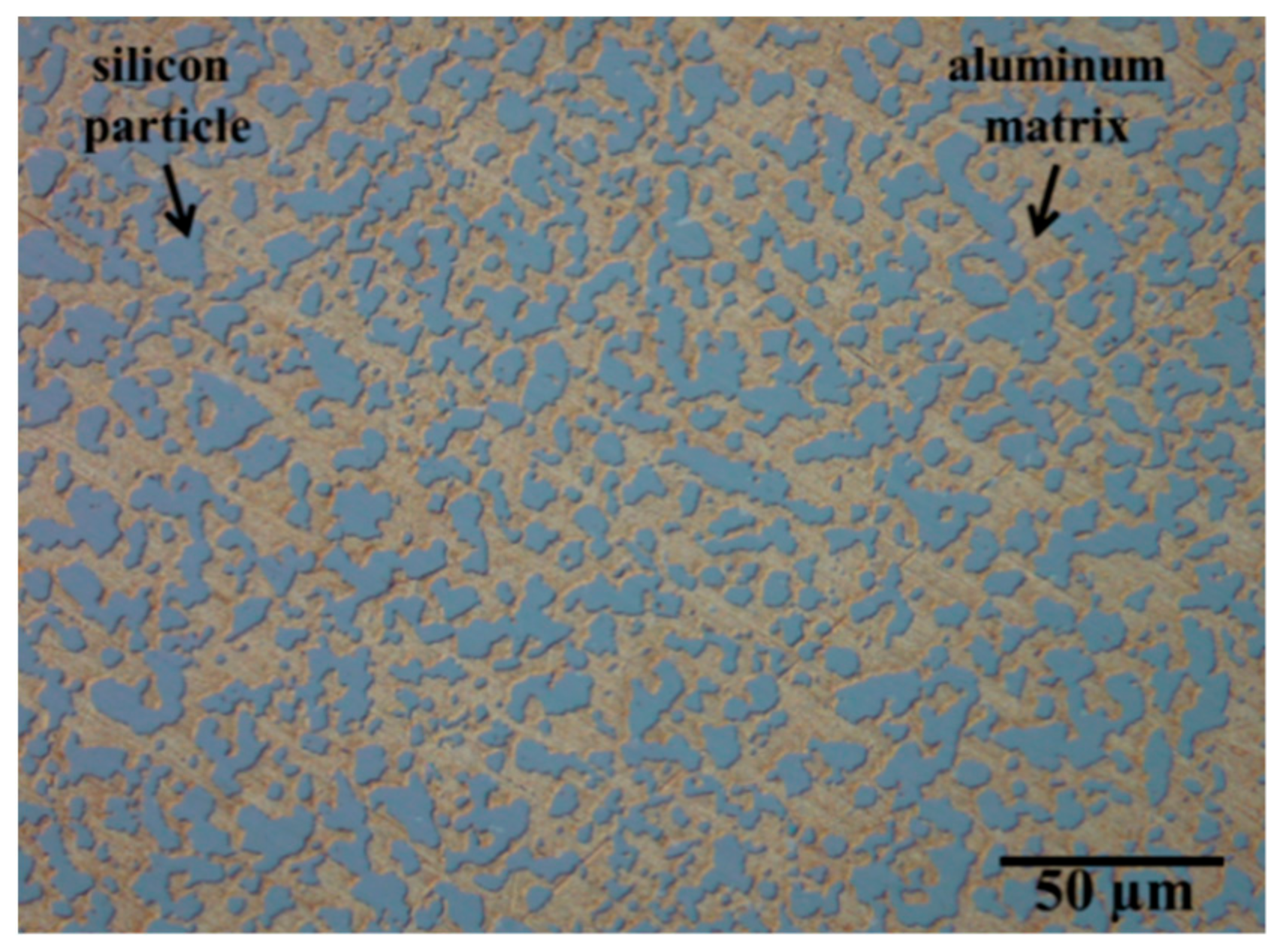
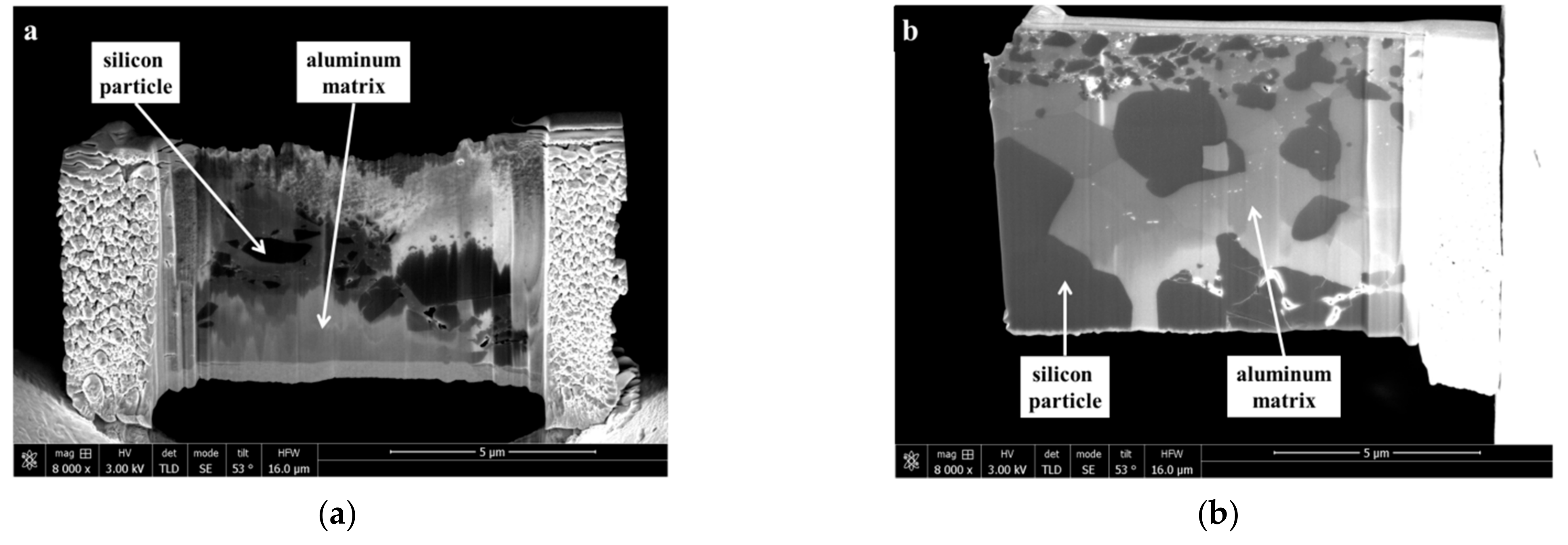
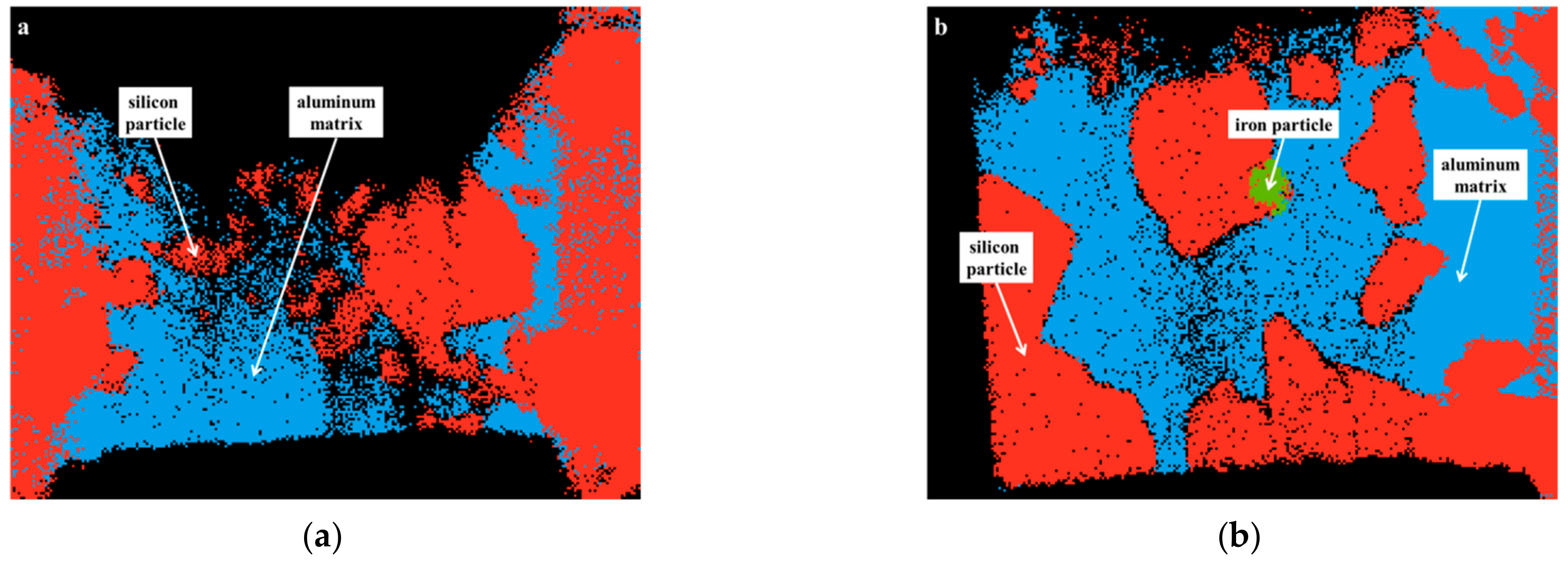
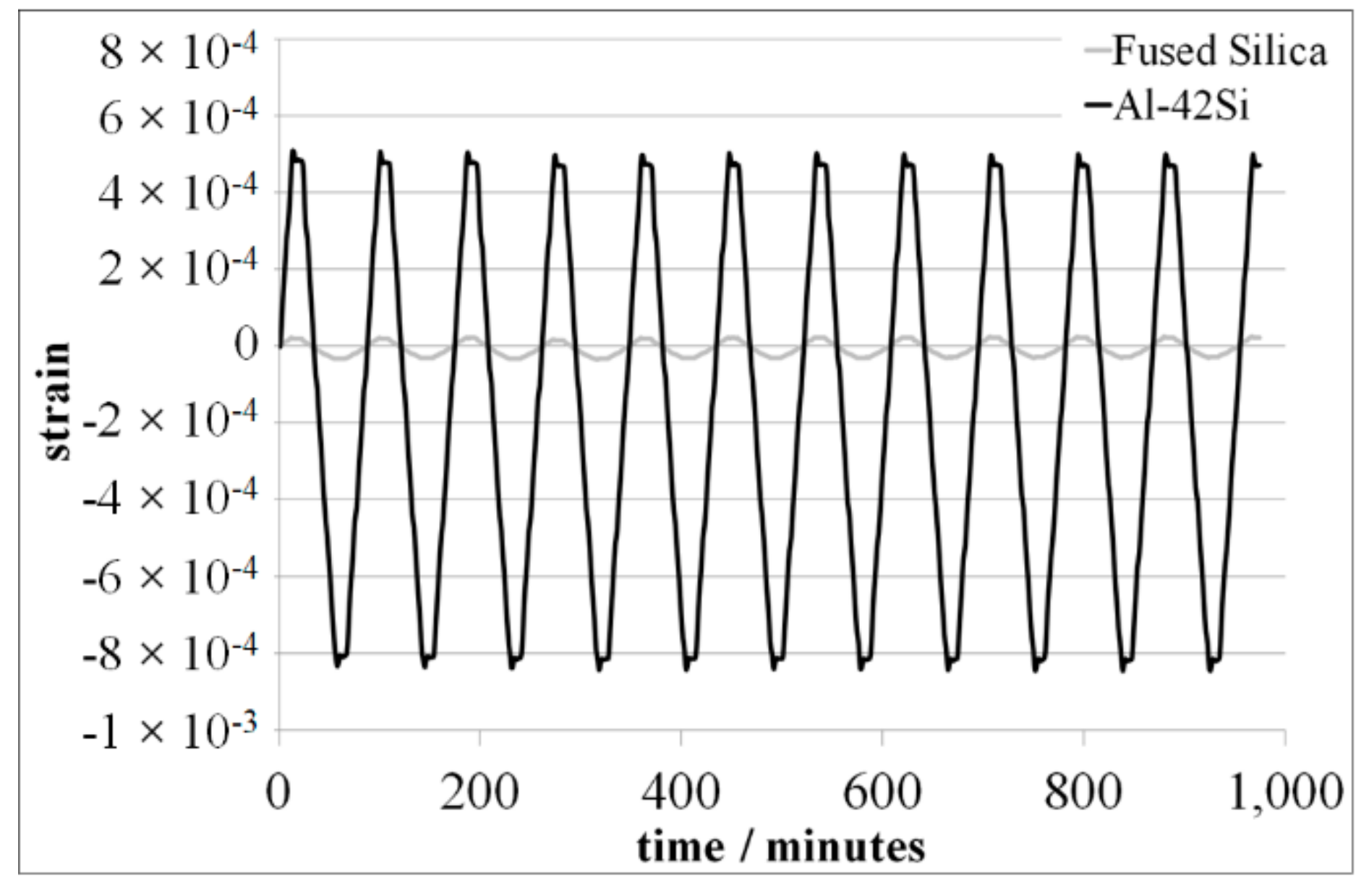
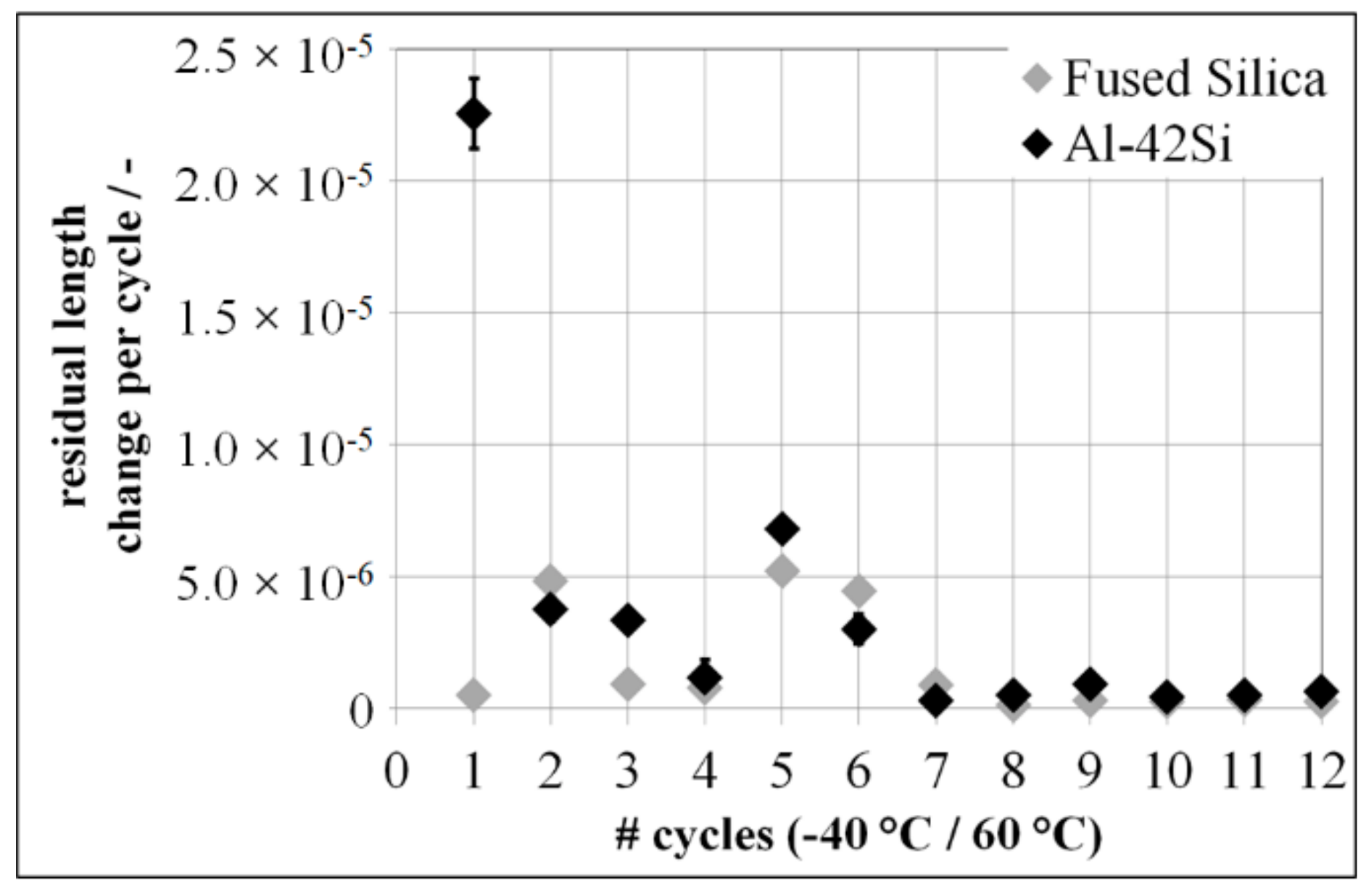
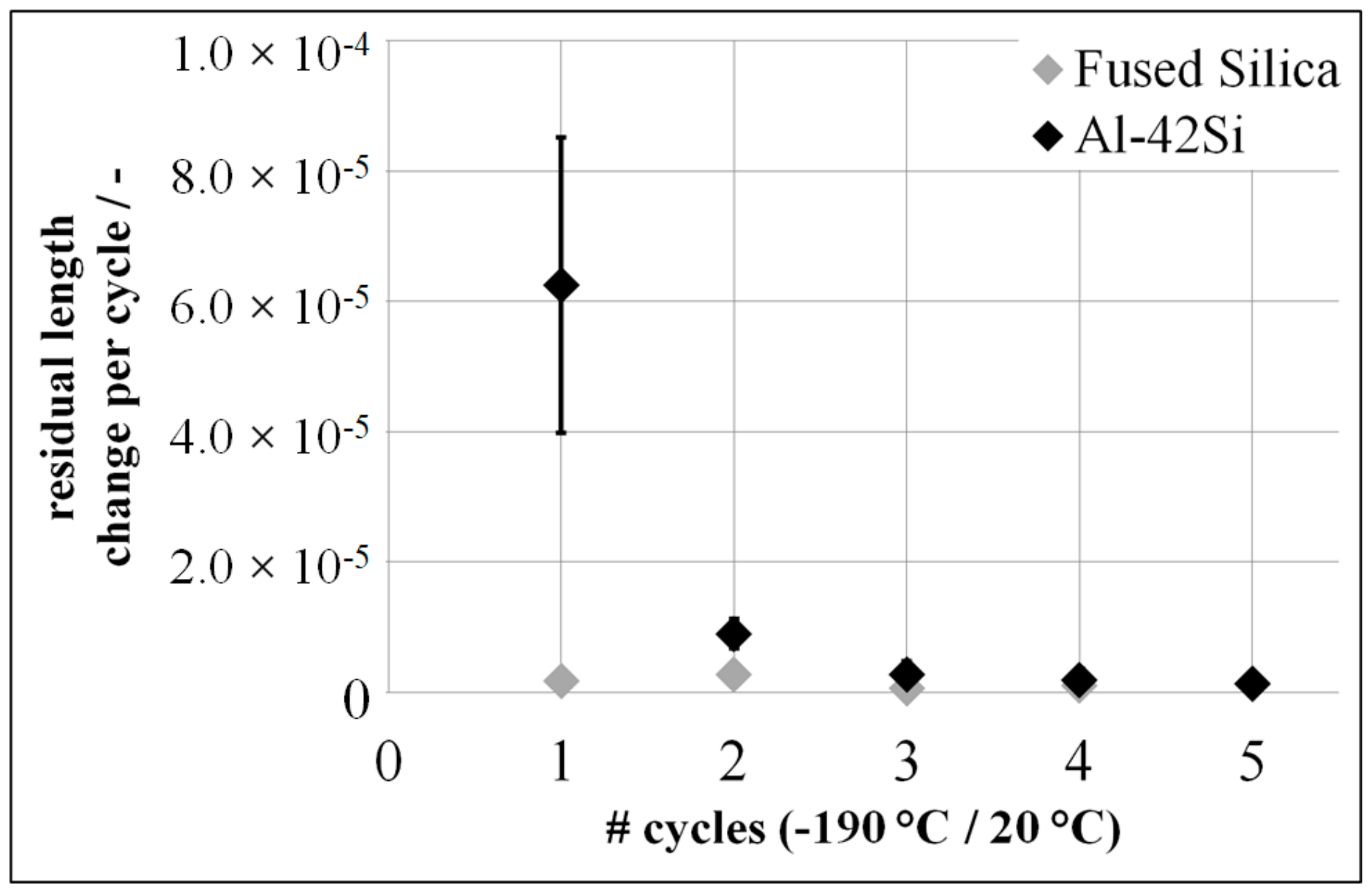
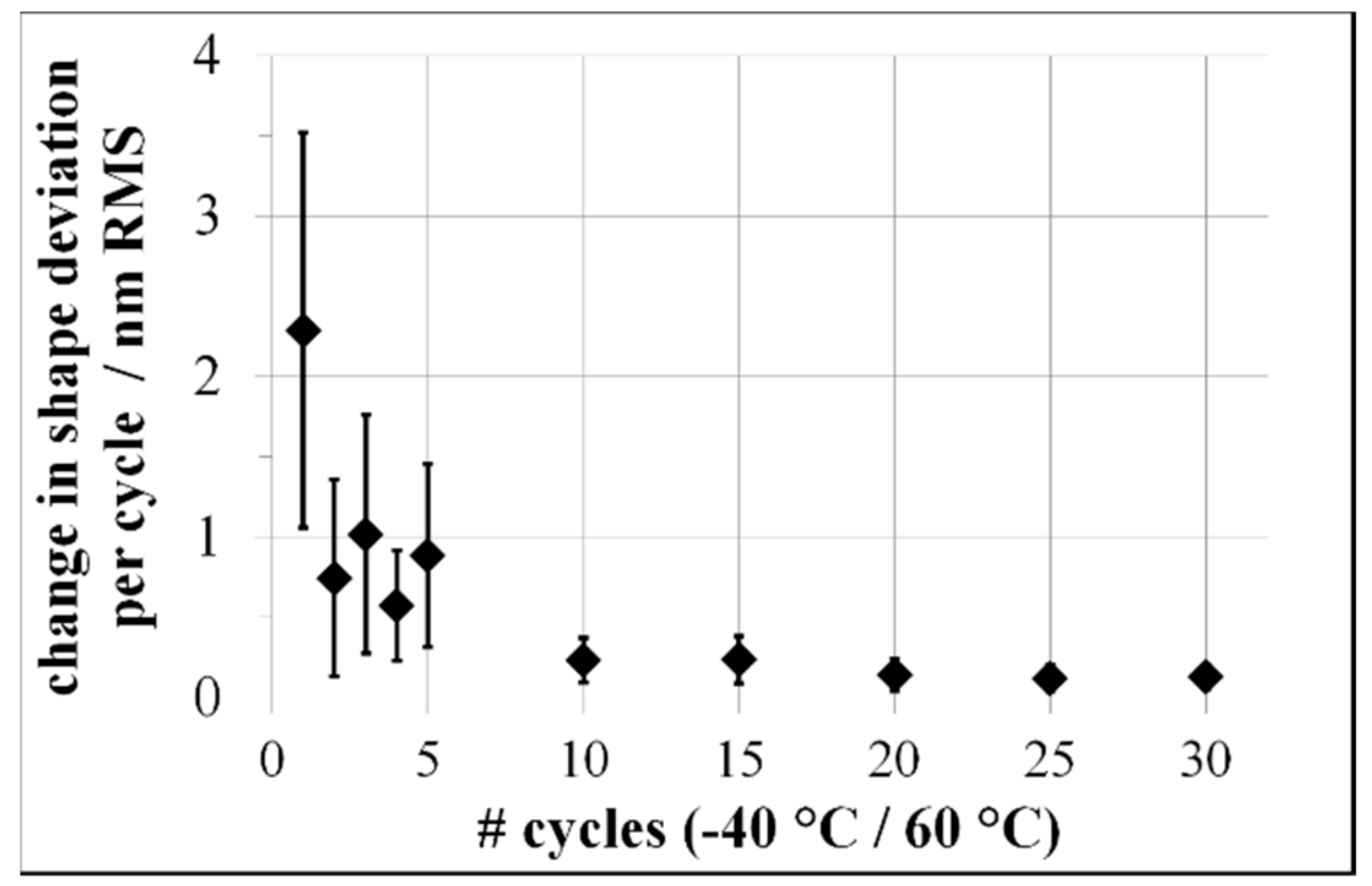

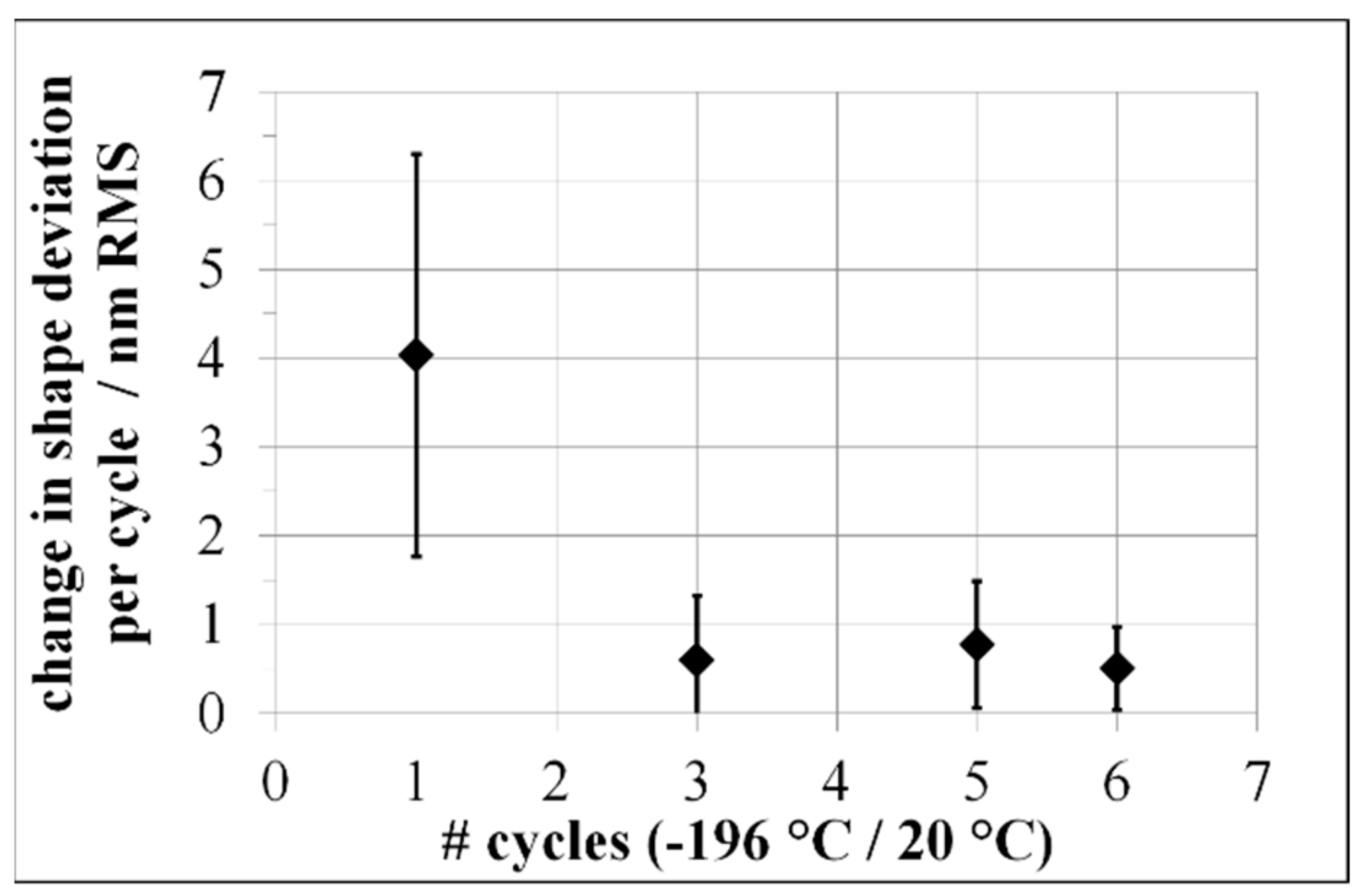


| Thermal Treatment | Al-42SiAR | Al-42SiTT |
|---|---|---|
| annealing | - | 360 °C |
| environmental thermal cycles | - | 30 cycles between −40 °C and 60 °C |
| cryogenic thermal cycles | - | 5 cycles between −196 °C and 20 °C |
| Al-42SiAR, Al Matrix | Al-42SiAR, Si Particle | Al-42SiTT, Al Matrix | Al-42SiTT, Si Particle | |
|---|---|---|---|---|
| frequency of dislocations | - | - | ++ | + |
| frequency of stacking faults | -- | - | -- | ++ |
Publisher’s Note: MDPI stays neutral with regard to jurisdictional claims in published maps and institutional affiliations. |
© 2022 by the authors. Licensee MDPI, Basel, Switzerland. This article is an open access article distributed under the terms and conditions of the Creative Commons Attribution (CC BY) license (https://creativecommons.org/licenses/by/4.0/).
Share and Cite
Kinast, J.; Tünnermann, A.; Undisz, A. Dimensional Stability of Mirror Substrates Made of Silicon Particle Reinforced Aluminum. Materials 2022, 15, 2998. https://doi.org/10.3390/ma15092998
Kinast J, Tünnermann A, Undisz A. Dimensional Stability of Mirror Substrates Made of Silicon Particle Reinforced Aluminum. Materials. 2022; 15(9):2998. https://doi.org/10.3390/ma15092998
Chicago/Turabian StyleKinast, Jan, Andreas Tünnermann, and Andreas Undisz. 2022. "Dimensional Stability of Mirror Substrates Made of Silicon Particle Reinforced Aluminum" Materials 15, no. 9: 2998. https://doi.org/10.3390/ma15092998
APA StyleKinast, J., Tünnermann, A., & Undisz, A. (2022). Dimensional Stability of Mirror Substrates Made of Silicon Particle Reinforced Aluminum. Materials, 15(9), 2998. https://doi.org/10.3390/ma15092998





